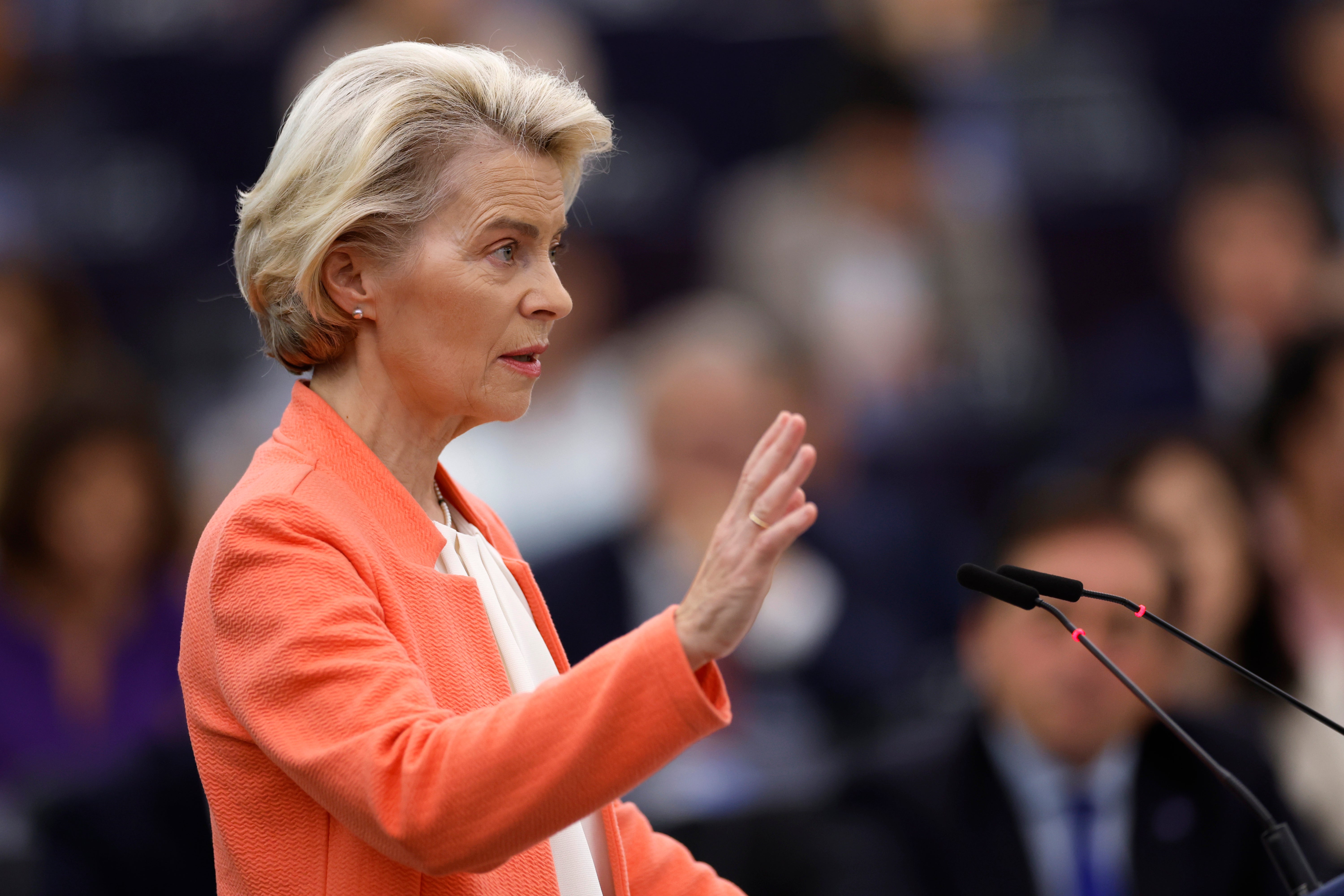Why support for Ukraine is in danger of splitting the EU
The European Union has reacted to the war in Ukraine with a rare unity – but splits are already emerging between countries offering support for as long as it takes and those agititating for Kyiv to cut its losses, writes Mary Dejevsky


This may have been a mistake, but I have always regarded Ursula von der Leyen as a rather low-key, matter-of-fact politician in a Merkel-esque mode. This week, she defied that image, delivering her fifth and possibly last State of the (European) Union address in untypically high-flown and futuristic terms.
It was a wide-ranging, well-organised – and rather good – speech, but little noted, alas, in the post-EU UK. And one of her main themes – how could it not be? – was Ukraine and its place in Europe. “History,” she said, “is now calling us to work on completing our Union”, and she set herself unambiguously on the side of EU enlargement, to include Moldova and the Western Balkans, plus, of course, Ukraine.
The war, now more than 18 months old, is one reason why von der Leyen’s address had been anticipated particularly keenly. This being her fifth year in office, some had also hoped for some hint as to whether she would seek a second term (which was not forthcoming). But the president of the EU Commission did make a firm commitment to EU enlargement, with this rationale.
In an obvious reference to Russia, and perhaps China, she said: “In a world where some are trying to pick off countries one by one, we cannot afford to leave our fellow Europeans behind.” She went on: “In a world where size and weight matters, it is clearly in Europe’s strategic and security interests to complete our Union.”
It was not ever thus. After the big enlargements of 2004 and 2007, which brought most of the former Eastern bloc states into the EU, there was little appetite for further expansion, with some feeling that Bulgaria and Romania had been accelerated to membership for political reasons before they were ready. Between then and now, only Croatia has joined the EU (in 2013).
For all this, EU enlargement can nonetheless be said to have changed history in at least two very big ways. Enlargement and the free movement that came with it was, at the very least, a contributory factor in the UK’s vote to leave. And pressure, in particular, from Poland, for Ukraine to be added to the candidates’ queue is an early link in the chain of events that led to the conflict of today.
In 2013, the EU offered Ukraine what was called an “association agreement”, a term, and a concept, designed as a diplomatic fudge. For some, such as Poland and Sweden, it was seen as a step towards membership; for others, it was seen as a permanent alternative – a way of keeping Ukraine (and potentially others) out.
Either way, the then Ukrainian president, Viktor Yanukovych, came under intense pressure to sign, with the US seeing it as a way to anchor Ukraine in the West and pushing enthusiastically from the sidelines. When Yanukovych refused at the last moment, under duress from Moscow, this triggered what became known as the Maidan uprising. Yanukovych fled; parts of eastern Ukraine rebelled against Kyiv, and Russia annexed Crimea.
A crucial element of the Maidan, however, which was as pertinent then as it is now, was the impassioned waving of EU flags by young Ukrainians on Kyiv’s Independence Square. Since then, Ukraine’s conflict with Moscow – limited mainly to eastern Ukraine from 2014, and all-out war since Russia’s invasion in February 2022 – has been identified not just with Ukraine’s now ubiquitous blue-and-yellow flag, but with the EU flag as well, which, by happy coincidence, shares the same colours.
And, as with the young protesters on the Maidan in 2014, Kyiv presents today’s war against Russia not just as a Ukraine-Russia conflict, but a West-East, Europe-Asia conflict, in which civilisation is pitted against barbarism. The EU responded to the Russian invasion with unaccustomed unity and decisiveness, which was not just rhetorical, but entailed large transfers of money and military assistance, a wholesale reorientation of the German economy, as well as special arrangements for what became millions of refugees. It was only logical that Ukraine’s president Volodymyr Zelensky should ask for Ukraine to join the EU, and for the EU to give it candidate status.
For a country to receive candidate status so quickly, however, on what were surely moral and political grounds, before it had come near to meeting most of the judicial and economic grounds, was highly irregular, and may risk future disappointment if the pace towards accession cannot be maintained.
It might perhaps be added that the clamour of Ukrainians on the Maidan – and their fury that Yanukovych had rejected the association agreement – reflected a view of the EU, as a fount of high living standards, impartial justice and institutional probity which would instantly accrue to any country that joined, that did not accord with reality.
It is not clear that Ukraine has developed any more realistic idea of EU membership between then and now. And the gap between Ukraine and the rest of the EU, while narrowed in some senses, such as democracy, has only widened in others. There also appears to be a widespread belief among Ukrainians that by defending European civilisation – as they would see it – by force of arms, they have demonstrated their country’s EU credentials, and deserve to be fast-tracked as soon as the war is over.
To her credit, von der Leyen did warn in her speech that there could be no primrose path to EU membership. By including Moldova and the Western Balkans in her list of those leading the queue, she also sent the message to Ukraine that it could not regard itself as unique – and to others lining up for membership that Ukraine would not be given a free pass. The standard conditions – in governance, the economy and the judiciary, to name but a few – would still apply.
It could, though, become a lot more complicated. For a start, there are practical considerations. Ukraine is a big country by EU standards. It is big territorially, and big in terms of population, even if, say, a fifth of its peacetime population of 44 million is now outside Ukraine, many indeed in EU countries. Even before the war, it was a poor country – poorer than Russia in per-capita GDP and purchasing power parity. It will be still poorer after the war and highly dependent on aid, at a time when the EU’s strongest economy, Germany, is languishing. Ukraine’s economic strength, what is more, lies in agriculture, which makes it a competitor for funds and markets with existing EU countries, especially Poland.
It is worth noting that while Poland, Hungary and others have been generous in their reception of refugees, that welcome may be cooling. Economic relations present a particular challenge. Ukraine’s EU neighbours have demanded special subsidies for their farmers before admitting imports of Ukrainian grain – even though Ukraine desperately needs new outlets for its grain, so long as its sea routes to the south are blocked. This foreshadows the difficulties Ukraine could encounter when the practicalities of its EU accession are seriously discussed.
Nor is it clear how long EU unanimity on Ukraine can last. Russia’s invasion propelled those members more inclined to doveish relations with Moscow into the camp of the hawks, such as Poland and the Baltic States, and it is true that the EU has since been united as almost never before. But there are divisions, some of which are playing out in the domestic politics of individual countries – in the current Polish parliamentary election campaign, for instance, and in Germany. Yet more could emerge if, for instance, the US were to scale back its support for Ukraine and support a peace process.
There could then be an open split between those determined to continue their military support for Ukraine, “for as long as it takes” – perhaps even to the point of sending troops – and those agitating for Kyiv to cut its losses and – even – trade land for peace. This could become an East-West split, or a “new”-“old” Europe split, of the sort that has grown between Poland and Hungary on the one hand and Brussels on the other, on such issues as the independence of the judiciary.
The tensions between old and new Europe have often manifested themselves in disagreement about Russian intentions. But they are rooted in something just as deep: whereas the “old Europeans” generally see the EU as a guarantee of post-1945 peace and a collective that is worth some sacrifice of national sovereignty, the “new” Europeans tend to see it quite differently, as a guarantee and defender of their independence and statehood.
This is a rift in attitude that has plagued the EU since its eastward expansion, and it cannot be excluded that the accession of Ukraine — on what terms, and when — could open a division that can no longer be bridged.




Join our commenting forum
Join thought-provoking conversations, follow other Independent readers and see their replies
Comments